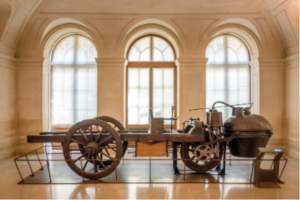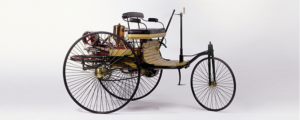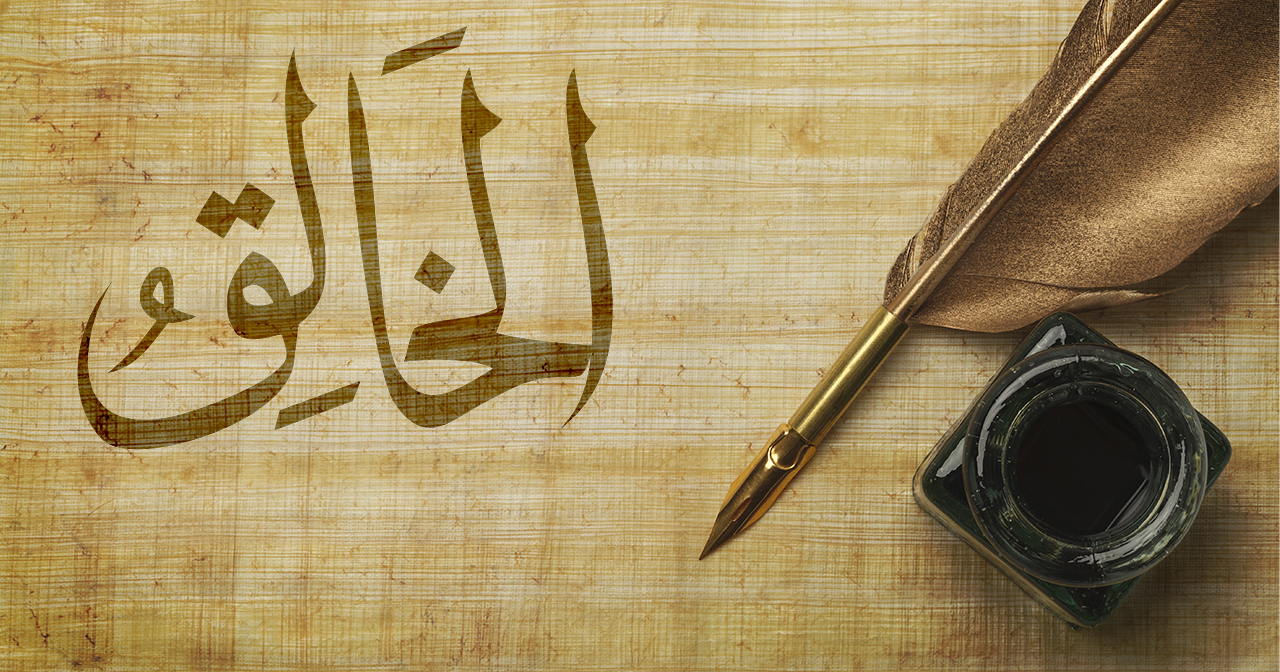Part 1 | Part 2 | Part 3 | Part 4 | Part 5 | Part 6 | Part 7 | Part 8 | Part 9 | Part 10 | Part 11 | Part 12 | Part 13 | Part 14 | Part 15 | Part 16 | Part 17 | Part 18 | Part 19 | Part 20 | Part 21 | Part 22 | Part 23 | Part 24
Most reasonable people accept that a meaningful page of text cannot be produced by pouring a pot of ink onto a blank piece of paper, regardless of how many times the process is repeated. What is our miraculous universe but a meaningful book written by the ink of atoms? Surely it has an author, one who deserves glorification, gratitude and praise. He is none other than Al-Khāliq, a name so majestic that it awakened the Prophet (sall Allāhu ʿalayhi wa sallam) at night on several occasions.
1: The linguistic meaning of Allah’s name Al-Khāliq
The root of this name comes from the three letters kha–la–qa, and has the following classical Arabic connotations:
The first:
ابتداع الشيء على مثال لم يسبق إليه
“To bring about something with no precedent.”[1]
This is why those who concoct a lie are, in Arabic, described as having engaged in khalq, having brought a lie into existence. Allah said regarding the pagans:
إِنَّمَا تَعْبُدُونَ مِنْ دُونِ اللَّهِ أَوْثَانًا وَتَخْلُقُونَ إِفْكًا
“You only worship, besides Allah, idols, and you create (takhluqūn) a falsehood.” [2]
The second:
Abū Bakr Al-Anbārī said:
الخلق في كلام العرب على وجهين: أحدهما الإنشاء على مثال أبدعه، والآخر: التقدير
“Al-khalq, in the Arabic language, has two usages: (1) Bringing about something without precedent (as was covered above), and (2) determining the measurement of matters.”[3]
The Arabs say:
خلقت الأديم إذا قدَّرته وقسته لتقطع منه مزادةً أو قِربةً أو خُفًا
“I did khalq of the leather” meaning: ‘I measured it in order to cut a specific amount to make an item.’” [4]
So, according to this second usage, khalq has the meaning of taqdīr, which is the accurate measurement of something.
Consider the manufacturing of a car. The first stage is taqdīr (determining measurements and specifications). Then, the physical parts are assembled. Both of these processes are referred to as khalq. We may add a third process: the beautification of the car. This is taṣwīr (giving form), alluding to yet another name of Allah – Al-Musawwir (The Giver of forms). [5]
So who is Allah, Al-Khāliq?
He is The One who creates according to the proper measure and proportion of each matter. He creates from nothing, determines the inner and outer proportions of creation according to their purpose, and His name is one of the most manifest in the realm of existence.
2: The difference in meaning when “khalq” is connected to Allah as opposed to man
The description of khāliq can be given to man as well, but when it is used in his reference, then it has a specific meaning.
Al-Khaṭṭābī said:
الخالق- هو المبدع للخلق المخترع له على غير مثال سابق، قال سبحانه: هَلْ مِنْ خَالِقٍ غَيْرُ اللَّهِ فأما في نعوت الآدميين فمعنى الخلق: التقدير
“Al-Khāliq is He who innovates in creation, who invents in unprecedented ways, He (subḥānahu) said: ‘Is there a khāliq other than Allah?’ [6] As for when it is used to describe man, what it means is taqdīr (the determination of measurement).”[7]
Thus, when Allah asserted in the Qur’ān that Prophet Jesus engaged in khalq (creation), it is to be understood as taṣwīr, as opposed to creating from nothing. [8]
These two meanings of khalq (i.e. inventing in unprecedented ways vs the determination of measurement) vary according to the context of where they appear in the Qur’ān.
For example, Allah said:
كَمَا بَدَأْنَا أَوَّلَ خَلْقٍ نُعِيدُهُ
“As we started the first creation (“khalq”), we shall repeat it…” [9]
So, in this context, khalq (creation) is to be understood in light of the first meaning: to bring about something in a way that does not have a precedent.
In another example, Allah said:
فَتَبَارَكَ اللَّهُ أَحْسَنُ الْخَالِقِينَ
“So blessed is Allah, the best of creators (khāliqīn).”[10]
In this context, khalq (creation) is to be understood in light of the second meaning (determining measurements), as the āyah asserts that there are many creators but Allah is the best of them. Since we know that none can bring something into existence from non-existence except Allah, the āyah must be implying the second meaning.
3: The differences between the names Al-Khāliq (The Creator), Al-Bāri’ (The Inventor) and Al-Musawwir (The Giver of forms)
These three names of Allah have appeared back to back in the Qur’ān, where Allah said:
هُوَ اللَّهُ الْخَالِقُ الْبَارِئُ الْمُصَوِّرُ لَهُ الْأَسْمَاءُ الْحُسْنَى يُسَبِّحُ لَهُ مَا فِي السَّمَاوَاتِ وَالْأَرْضِ وَهُوَ الْعَزِيزُ الْحَكِيمُ
“He is Allah, the Creator, the Inventor, the Giver of forms. To Him belong the Best Names. All that is in the heavens and the earth glorify Him. And He is the All-Mighty, the All-Wise.”[11]
As for Al-Khāliq, we have already covered that it has origins in the term taqdīr (determining measurements).
Al-Bārī’ (The Inventor) has origins in the term bur’, which refers to something being free from all other matters. Al-Bāri’, therefore, is He who creates in faultless ways, free from all defects.
Al-Musawwir (The Giver of forms), is the one who fashions the image of creation in the finest of ways.
Hence, Allah is Al-Khāliq, He who first determines the measurements and creates without precedent. And He is Al-Bāri’, who removes flaws from His creation, allowing them to carry out their respective functions in life. And He is Al-Musawwir, who then gives His creation their final splendid form and fine features which differentiate one creation from another. [12]
An analogy of this – and to Allah belongs the greatest of examples – is that of he who aspires to erect a building. First, he employs an architect to design the building and determine its measurements. A quantity surveyor may also be needed to quantify the required materials, and a structural engineer is needed to carry out the calculations. Next, he employs a builder to execute the design accordingly and precisely. Finally, the building is decorated and given its finishing touches, endowing it with its unique features to differentiate it from other buildings.
Clearly, many professionals are required in the process of constructing any one building. Furthermore, the architect never designs without precedent. They are – in one way or another – benefiting from, copying, or adapting the designs of others. Similarly, the builders do not bring materials such as iron, wood and cement into existence, rather they rely on existing materials and merely assemble or rearrange them.
As for the manner in which Allah creates, the matter is altogether different. He has no partner, advisor, or assistant. He is Al-Khāliq, Al-Bāri’ and Al-Musawwir all in One. Should He wish, He could create using existing matter or without it entirely. He also creates with precedent, but should He wish, He has the power to create without any precedent.
Given this explanation, it becomes clear why the Qur’ān makes such frequent mention of Al-Khāliq, and cites the many examples of the majesty of His creation. For example:
– The Qur’ān has informed its readers that in the entirety of existence, there is no true khāliq but Allah. Allah asks:
يَا أَيُّهَا النَّاسُ اذْكُرُوا نِعْمَتَ اللَّهِ عَلَيْكُمْ هَلْ مِنْ خَالِقٍ غَيْرُ اللَّهِ يَرْزُقُكُمْ مِنَ السَّمَاءِ وَالْأَرْضِ
“O mankind! Remember the Grace of Allah upon you! Is there any creator other than Allah who provides for you from the sky and the earth?” [13]
– The Qur’ān asserts that man will never be to recreate even the simplest of beings, a fly being one example. Allah said:
إِنَّ الَّذِينَ تَدْعُونَ مِنْ دُونِ اللَّهِ لَنْ يَخْلُقُوا ذُبَابًا وَلَوِ اجْتَمَعُوا لَهُ
“Surely those whom you call upon besides Allah cannot create a fly, even if they were to gather together for that purpose…”[14]
– The Qur’ān even challenges man to find a single fault in His creation, saying:
مَا تَرَى فِي خَلْقِ الرَّحْمَنِ مِنْ تَفَاوُتٍ فَارْجِعِ الْبَصَرَ هَلْ تَرَى مِنْ فُطُورٍ (3) ثُمَّ ارْجِعِ الْبَصَرَ كَرَّتَيْنِ يَنْقَلِبْ إِلَيْكَ الْبَصَرُ خَاسِئًا وَهُوَ حَسِيرٌ (4)
“You do not see in the creation of the Most Merciful any fault. So return [your] vision [to the sky], do you see any breaks? Then look again and yet again: your sight will return to you in a state of humiliation and worn out.” [15]
– The Qur’ān asks its readers whether they have ever seen anyone creating in the same manner as Al-Khāliq:
أَمْ جَعَلُوا لِلَّهِ شُرَكَاءَ خَلَقُوا كَخَلْقِهِ فَتَشَابَهَ الْخَلْقُ عَلَيْهِمْ قُلِ اللَّهُ خَالِقُ كُلِّ شَيْءٍ وَهُوَ الْوَاحِدُ الْقَهَّارُ
“Or have they attributed to Allah partners who created like His creation so that the creation of each seemed similar to them?” Say, ‘Allah is the Creator of all things, and He is the One, the Prevailing.’” [16]
– The Qur’ān informs humanity that what they know of His creation pales in comparison to what He has actually created, saying:
وَيَخْلُقُ مَا لَا تَعْلَمُونَ
“… and He creates what you have no knowledge of.” [17]
4: The effects of believing in His name Al-Khāliq
To call upon Him using this name
Often, the first and ideal step in dealing with damaged goods is to contact the manufacturer. However, due to financial constraints, the remote location of the manufacturer, or other factors, this option is often impractical. However, as a Muslim who believes in Al-Khāliq, inaccessibility is never an issue and unavailability is not on the cards.
The Prophet (sall Allāhu ʿalayhi wa sallam) said: “The best manner of asking for forgiveness is to say:
اللَّهُمَّ أَنْتَ رَبِّي لاَ إلهَ إلاَّ أنْتَ خَلَقْتَنِي وَأَنَا عَبْدُكَ ، وَأنَا عَلَى عَهْدِكَ وَوَعْدِكَ مَا اسْتَطَعْتُ ، أعُوذُ بِكَ مِنْ شَرِّ مَا صَنَعْتُ ، أبُوءُ لَكَ بِنِعْمَتِكَ عَلَيَّ ، وأبُوءُ بِذَنْبِي ، فَاغْفِرْ لِي ، فَإنَّهُ لاَ يَغْفِرُ الذُّنُوبَ إلاَّ أنْتَ
‘O Allah. You are my Lord. None has the right to be worshipped except You. You created me and I am your servant and I abide by your covenant and promise as best I can. I seek refuge in you from the evil which I have committed. I acknowledge your favour upon me and I knowledge my sins, so forgive me, for verily none can forgive sin except you.’” [18]
In fact, the Prophet (sall Allāhu ʿalayhi wa sallam) once woke up during the night before the dawn prayer. He stared into the sky and recited the verses:
رَبَّنَا مَا خَلَقْتَ هَذَا بَاطِلًا سُبْحَانَكَ فَقِنَا عَذَابَ النَّارِ
“Our Lord! You have not created all this without purpose. You are far above that, so protect us from the torment of the Fire” [19]
Then he washed, prayed and went back to sleep. He did this on three occasions during that one night before fajr. [20]
Similarly, whilst a man was once lying on his mattress, he looked contemplatively into the skies and, in his moment of awe, said:
أشهد أن لك ربا وخالقا اللهم اغفر لي
“I testify that you have a Lord who created you. O Allah, forgive my sins.”[21]
As a result, Allah turned to him in forgiveness.
Perhaps it is your unending bachelorhood, deteriorating health, enduring anxiety, or damaged īmān, regardless of the nature of your injury, raise your hands to Him and realise that you have found your very creator.
To realise that only The Creator is deserving of unconditional obedience
In the case where there is a conflict between the two, how is it possible that one would place the obedience of people before that of their Maker? Surely it only makes sense that, since He is the exclusive creator, sole inventor and only giver of form, no mortal must dare assume that they have a greater right of being obeyed and pleased than Al-Khāliq. After all, creation justifies command.
Allah said:
أَلَا لَهُ الْخَلْقُ وَالْأَمْرُ
“Unquestionably, His is the creation and the command.” [22]
Logic says:
“I am breathing His air, walking His land, living beneath His roof, eating from His provisions and using the vehicle – the human body – which He loaned me, so everyone and everything else must take second place when His pleasure comes head to head with that of family, friends, customs, or even my own urges. After all, I am His.”
Logic also says:
“Every device comes with the manufacturer’s instruction manual which describes how it is to be used, protected from harm and how to spot signs of malfunction. I, as a human being, am the most sophisticated of all creatures. Hence, I am most in need of a manual to live by and refer to for my wellbeing, even if my short-sighted urges feel otherwise.”
This manual is called the Qur’ān, and its instructions include:
– Do not cut family ties
– Resist desires that are prohibited, for their short-term pleasure reaps long term pain
– Distance yourself from the prohibited financial transactions
– Your five prayers are essential for your worldly and post-worldly wellbeing
– Your hijāb must never be compromised, with a description of how it should look
– Friends will make you or break you, so choose them wisely
And so on.
Hence, should any of its divine instructions clash with those of an employer, spouse or trend, then your reference should always be the manual which your Maker has so ever mercifully sent your way.
The Prophet (sall Allāhu ʿalayhi wa sallam) said:
لا طاعةَ لمخلوقٍ في معصيةِ الخالقِ
“There is no obedience to the creation if The Creator will be disobeyed.”[23]
To see the greatness of The Creator through the lens of His creation
Allah has praised those Muslims who do just this, saying:
الَّذِينَ يَذْكُرُونَ اللَّهَ قِيَامًا وَقُعُودًا وَعَلَى جُنُوبِهِمْ وَيَتَفَكَّرُونَ فِي خَلْقِ السَّمَاوَاتِ وَالْأَرْضِ رَبَّنَا مَا خَلَقْتَ هَذَا بَاطِلًا سُبْحَانَكَ فَقِنَا عَذَابَ النَّارِ
“Those who remember Allah while standing or sitting or lying on their sides and give thought to the creation of the heavens and the earth, saying, ‘Our Lord, You did not create this aimlessly; Glory be to You; so protect us from the punishment of the Fire.’” [24]
Allah also said:
قُلِ انْظُرُوا مَاذَا فِي السَّمَاوَاتِ وَالْأَرْضِ
“Say, ‘Look at what is in the heavens and earth…’ [25]
Allah also said:
أَوَلَمْ يَنْظُرُوا فِي مَلَكُوتِ السَّمَاوَاتِ وَالْأَرْضِ وَمَا خَلَقَ اللَّهُ مِنْ شَيْءٍ
“Do they not look into the dominion of the heavens and the earth and everything that Allah has created…”[26]
The scientific community today considers the concept of ‘randomness’ to be an acceptable scientific explanation for the existence of the universe. They vehemently reject a creator despite the signs of design in the universe being infinitely more manifest than those of randomness. Such signs only ever increase, building a stronger case for Al-Khāliq. Consider the following:
In 1966, physicists had just two criteria for a planet to support life: The right kind of parental star and a planet just the right distance away from that star. That is it. It inspired scientists to search for alien life. They had hoped to pick up radio signals for coded intelligence but the silence from the universe was disappointing.
Since 1966, the necessary parameters for life grew from 2 to 10 to 50 to 200 specific conditions [and counting]. As a result, the chances of life, as we know it today, existing somewhere out there in the universe only continues to decrease.
Here are just some of the conditions needed:
– A spiral galaxy. Only 6% of known galaxies are spiral.
– The planets around it have to do their job too. They must shield the planet that supports life from asteroids, but not block the sun. For example, Jupiter shields the Earth from asteroids, such as the one from July 1994, but it is also not so big that it would disturb the planet’s orbit.
– The orbits should be closer to circular than elliptical. Otherwise, the planet would get too close or too far from the sun. Our solar system is the only known one with near-circular orbits that allow for even and balanced seasons for our survival.
– It must have an Ozone layer to absorb the sun’s ultraviolet rays.
– The Ocean to Continent ratio must be intact.
– It must have a moon of the right size and distance. The moon’s mass is 1.2% of that of the Earth and plays a pivotal role in the ocean’s high and low tides. If ocean water did not move, it would decay in stillness, among other harms.
– The planet’s crust must be the right thickness. If it were too thick, it would absorb too much oxygen thus not allowing for it to be recycled. If it were too thin, then volcanic and tectonic activity would become too intense.
All of these factors are necessary for life to survive and thrive. Many of these factors are dependent upon one another and so a dependency factor must be accounted for. The probability of a planet having just thirty-two of these conditions is one in a Tredecillion, or one followed by forty-two zeros. For the sake of visualization, that is 1 in 1,000,000,000,000,000,000,000,000,000,000,000,000,000,000 chance.
Commenting on the complexity of the universe, Dr. John Lennox, University Professor of Mathematics at Oxford said, “The more we get to know about our universe, the more the hypothesis that there is a Creator gains credibility as the best explanation of why we are here.”
When will the scientific community re-admit to the existence of a creator as a scientific conclusion? When will they profess to the reality of Al-Khāliq, the signs of Whom are laden within the universe? [27]
Now, after having looked at some of the cosmic signs of Al-Khāliq, let us zoom in at those closer to home.
The origin of man was from dust, then thereafter from semen, which develops into an ‘alaqa (a clinging matter), then becomes a mudgha (a chewed like matter). Then, it is given bones, then dressed in flesh, then endowed with a soul and gifted hearing and seeing. Then, he emerges from the womb of his mother as an utterly helpless being, developing in gradation till he is able to stand upright, travel the earth, accumulate money, build towers and cities, and attain the highest levels of understanding and sophistication. So, praise be to Al-Khāliq who has perfected all matters.
Man’s inventions are in constant need of adaptation and improvement. For example, consider the very first car. Nicolas-Joseph Cugnot (26 February 1725 – 2 October 1804) was a French inventor who built the world’s first full-size, working, self-propelled mechanical land-vehicle, effectively the world’s first automobile.

Then, on January 29, 1886, Carl Benz applied for a patent for his “vehicle powered by a gas engine.” In July 1886 the newspapers reported the first public outing of the three-wheeled Benz Patent Motor Car, model no. 1.

Lights comprised of candles within a lantern. Activating the vehicle was not via a key, rather it was an external and publicly exposed process. It is, in our eyes today, the epitome of simplicity and perhaps even a cause of laughter.
In 1894 Louis Antoine Kriéger (1868–1951) of Paris, France, began designing and building electric automobiles.
In 1903 Kriéger produced the first hybrid electric vehicle (HEV). It had front wheel drive, power steering, and a petrol engine that supplemented the battery pack.

Each generation adapted what came before them, refining the processes and advancing the technology. The process of development took place gradually over many years. Fast forwarding to our generation, cars have evolved to look like this:


Compare these last two images with the first two.
The same can be said about the development of computers, communication, aeroplanes and so on. The rate of development between one generation and another is phenomenal and the difference between one model and another is profound.
With that said, consider the design of man. From the time of Adam, the first man, until our time today – thousands of years later – have you ever heard of man-model no. 1, 100 or 1000? Or are they the exact same design? Those who lived 20 years ago, 200 years ago or 2000 years ago were identical with respect to the miraculously sophisticated system for vision, the intricate auditory system and the remarkable mechanisms for digestion, immunity, and information processing and expression. The first of men, Adam, and the last of them are of the same “model” of miraculous design.
صُنْعَ اللَّهِ الَّذِي أَتْقَنَ كُلَّ شَيْءٍ
“Such is the Work of Allah, Who perfected all things…” [28]
Now, consider the signs of Al-Khāliq within yourself:
– The journey which the sperm makes in order to get to the egg is equivalent to us sprinting for 150 kilometres nonstop. The journey is not straight forward. Many obstacles and hurdles await it, yet it overcomes them without losing direction.
– Your heart weighs around 321 grams. Its size is around that of your fist and beats around 60 to 80 times per minute. On a yearly basis, it beats around 40 million times and pumps around 2200 gallons of blood per day, and approximately 56 million gallons of blood per lifetime.
– The blood which the heart pumps to the brain returns back to the heart within 8 seconds, and the blood which it pumps to your toes – the furthest distance from the heart – returns back to the heart within 18 seconds.
– The blood is home to around 5 million red blood cells per cubic millimetre of blood. If red blood cells from one human were to be placed side by side, they could cover the surface of the Earth 6 to 7 times over.
– Platelets are the cells that circulate within our blood and bind together when they recognize damaged blood vessels. A normal platelet count ranges from 150,000 to 450,000 platelets per microliter of blood.
– The human body is home to over 600 muscles, and the average sized muscle is comprised of approximately 10 million muscle fibres.
– The human body has around 2 to 5 million sweat secreting glands to regulate our body temperatures.
– The brain is home to approximately 100 billion neurons. Each neuron forms about 1,000 connections to other neurons, amounting to more than a trillion connections.
– Neurons combine so that each one helps with many memories at a time, exponentially increasing the brain’s memory storage capacity to something closer to around 2.5 petabytes (or a million gigabytes). For comparison, if your brain worked like a digital video recorder in a television, 2.5 petabytes would be enough to hold three million hours of TV shows. You would have to leave the TV running continuously for more than 300 years to use up all that storage.
– The human retina contains about 120 million photoreceptor cells. How it communicates this information to the brain, and how the brain then processes this information bringing about love, hate, hope, despair, fear, security and so on, is a completely separate and highly sophisticated discussion.
– The tongue has a role to play during the process of chewing, swallowing and tasting food as well as for speech and sounds. It has 17 muscles to allow it to move in any direction. The surface of the tongue has 9000 taste receptors to differentiate between sweet, salty, sour, and bitter.
– One kidney weighs around 150 grams and is made up of about a million filtering units called nephrons. Each hour, it filters 1800 litres of blood and about 1 and ½ litres are extracted in the form of urine. Consider the difficulty experienced by those who are undergoing dialysis treatment. They are required to spend around 12 hours a week connected to 150kg worth of machinery, let alone the side-effects, in order to carry out what your 150 gram kidney is able to carry out within moments.
– Your outer layer of skin, the epidermis, replaces itself every 35 days. You are given a new liver every six weeks. Your stomach lining replaces itself entirely every 4 days, and the stomach cells that are involved in digesting food are replaced every 5 minutes. Our entire skeletal structures are regenerated every 3 months. Your entire brain replaces itself every two months. In fact, the entire human body, right down to the last atom, is replaced every 5-7 years.
How is it, then, that if one’s brain replaces itself every two months, they can still retain long term memories? The nerve cells in the human body are the only exception to regeneration. If they did regenerate, say, once every six months, you would need to relearn your language every time.
Consider also the sounds within the digestive system following the consumption of an apple, the sounds of a real factory at work. Consider how matters would have been if people were able to hear such sounds from each other, whether at interviews, marriage meetings, circles of knowledge, communal prayers or around the dinner table. One would need to escape to a remote corner to eat and drink in dignifying solitude. This dilemma has been, by divine design, overcome.
The briefest moments of reflection on creation are sufficient to leave one lost for words, and such bewilderment will only ever intensify as time progresses and discoveries are made. Our only words are therefore:
فَتَبَارَكَ اللَّهُ أَحْسَنُ الْخَالِقِينَ
“… So blessed be Allah, the Best of creators” [29]
Contentment with all what Al-Khāliq sends your way
As a Muslim, you have every reason to experience real contentment in what Allah has chosen for you, even if the associated pain causes you to doubt. Would a Lord who has named Himself Al-Khāliq choose anything but what is best for His righteous servants?
Allah said:
أَلَا يَعْلَمُ مَنْ خَلَقَ وَهُوَ اللَّطِيفُ الْخَبِيرُ
“Does He who created not know, while He is the Subtle, the Acquainted?” [30]
Of course, He who created you knows you better than you know yourself. Thus everything He commands, prohibits, or sends your way is, as the āyah above alluded to, out of His Subtlety towards you, and out of Him being Acquainted with you.
Trust Him, be content with Him, and watch how you will live in bliss with Him.
Source: www.islam21c.com
Notes:
[1] Tahdhīb al-Lughah
[5] However, even this third phase of taṣwīr can also be described as khalq.
[8] Allah said: أَنِّي قَدْ جِئْتُكُمْ بِآيَةٍ مِنْ رَبِّكُمْ أَنِّي أَخْلُقُ لَكُمْ مِنَ الطِّينِ كَهَيْئَةِ الطَّيْرِ فَأَنْفُخُ فِيهِ فَيَكُونُ طَيْرًا بِإِذْنِ
“’Indeed I have come to you with a sign from your Lord in that I design (akhluqu) for you from clay that which is like the form of a bird, then I breathe into it and it becomes a bird by the permission of Allah”
[18] Al-Bukhārī, on the authority of Shaddād b. Aus
[19] And he continued reciting until āyah 194
[21] Al-Kāfī al-Shāfī. Ibn Ḥajar mentions that there is an unknown narrator within its chain of transmission
[23] Al-Istīʿāb, Ibn ʿAbd al-Barr
[27] https://www.safinasociety.org/post/the-odds-against-life









